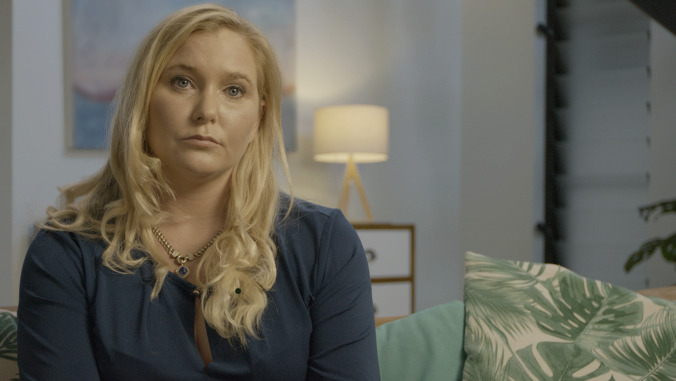Surviving Jeffrey Epstein puts the spotlight on the survivors of his evil

Jeffrey Epstein was a monster, a smirking sociopath who believed he was superior to everyone around him. It’s no wonder he appealed to so many powerful people, including princes and presidents. Film and TV have an unfortunate tendency to romanticize monsters, especially if their lives boast a veneer of glamour. Epstein, who grew up in working-class Brooklyn, has been compared to Jay Gatsby and Tom Ripley (the charming murderer from the Patricia Highsmith novels). Like Gatsby and Ripley, Epstein achieved great wealth (arguably through just as questionable means), but as the saying goes, behind every fortune, there’s a crime. In Epstein’s case, his fortune was both the weapon used to carry out his crimes and his personal shield against any accountability.
Surviving Jeffrey Epstein, a two-part Lifetime documentary that airs this Sunday and Monday, doesn’t romanticize Epstein’s backstory or attempt to whitewash any of his deeds. It centers on his victims, whose lives he maliciously upended with precision and cold-blooded calculation. If you’ve followed the Epstein case, as well as the recent arrest of his alleged accomplice, Ghislaine Maxwell, you are aware of what survivor Virginia Giuffre describes as Epstein’s “pyramid scheme,” where his victims were used to recruit fresh victims, who would go on to do the same. Unlike Epstein and Maxwell, these women have consciences, so their pained faces reveal the remorse they still feel for their involvement.
Epstein owned a $22 million home on the island of Palm Beach, in what’s called “millionaire and billionaire’s row.” It’s a just a short drive further west to the poorer parts of Palm Beach—several tax brackets traversed in under 20 minutes. This area provided the “pool of young girls” for Epstein to prey upon. When Epstein found Courtney Wild, she was just 14, an awkward child with braces. Wild is now in her 30s, but the documentary frequently shows us photos of the survivors in their youth so we never lose sight of Epstein’s evil.
Wild, like most of the survivors interviewed, painfully recalls the moment the “massage” Epstein paid them to give him transformed into sexual assault. “I remember walking down the staircase after being given the $200,” Wild says, “and I’m so upset and disgusted and I’m feeling like I’ll never come back here ever again. And then, after a week went by, I just downplayed the situation myself. Maybe it wasn’t so bad and I could go back because I do need more money.” This was the sick cycle: Epstein would allegedly rape these girls and leave them with spirits so broken they’d return to him, falsely believing they’re damaged and deserve nothing better. Soon, Wild was paid to bring up to 30 minors to his house. She started taking Xanax to ease her torment and guilt. Eventually she dropped out of school. It was a common theme for all his victims, and they were a specific “type”: very young, thin, and white.
Wild’s story is perhaps the most affecting in the documentary, but the others are no less shocking. In New York, Epstein preyed on struggling models, who also fit the desired ethnic and physical profile. Interviews with attorney Spencer Kuvin, who represented three of the survivors, and Dr. Janice Stevenson, an expert in trauma recovery, provide important background, but the documentary is at its best when it focuses on the survivors. Their personal accounts are devastatingly raw and will leave you angry, horrified that this went on for so long, either undetected or ignored. It’s all the more enraging to discover how Epstein’s legal team tried to destroy them with a campaign of harassment and intimidation.
“It’s completely appropriate to investigate complaining witnesses,” explains Epstein’s lawyer, Alan Dershowitz. “Complaining witnesses are fair game.” He’s talking about children: Wild was barely 18 at the time and she and other survivors were vilified as “prostitutes” when Epstein was charged with sexual abuse in 2005. (Minor girls can no more consent to prostitution than they can consent to sex.) Through Wild’s eyes, we see Epstein twist the legal system to his benefit. He received a generous plea deal in 2005 and barely served a year in prison. Even as an official sex offender, Epstein was still embraced by the wealthy and powerful upon his release.
The title Surviving Jeffrey Epstein reinforces the important fact that the women Epstein manipulated and abused ultimately survived his actions. He didn’t break them, and most will spend their lives as advocates against sexual exploitation. (Lifetime has partnered with Rise Up Against Abuse to run a PSA during the airings of the documentary to encourage other survivors. The cable network will also run a PSA from the Rape, Abuse & Incest National Network to provide hotline resources for those in need.)
Lifetime has pointed out the timing of the documentary, which airs “on the anniversary of disgraced financier and alleged sexual predator Jeffrey Epstein’s death.” This isn’t meant to elicit sympathy for Epstein, however. His death was ruled a suicide, and this final act denied the many women he abused closure and justice. He was only ever technically convicted of prostitution. “He wins every fucking time,” survivor Chaunte Davies says, through tears, and like the documentary itself, it’s heartbreaking yet necessary to watch.